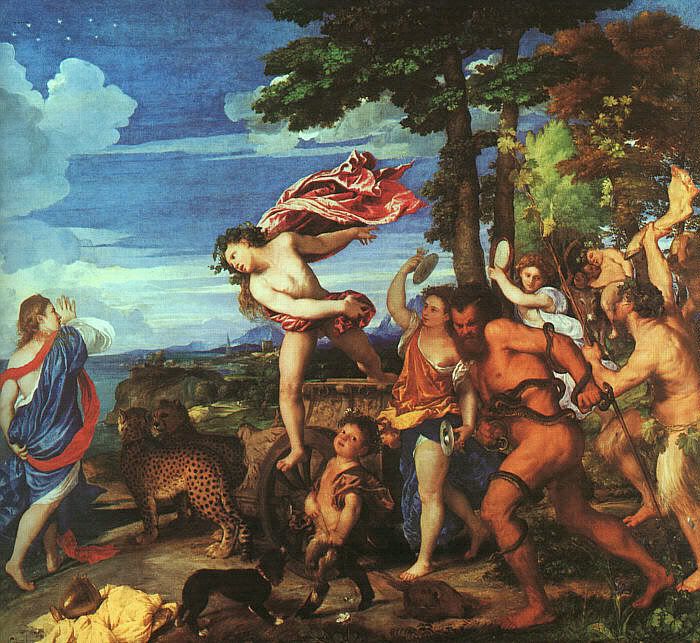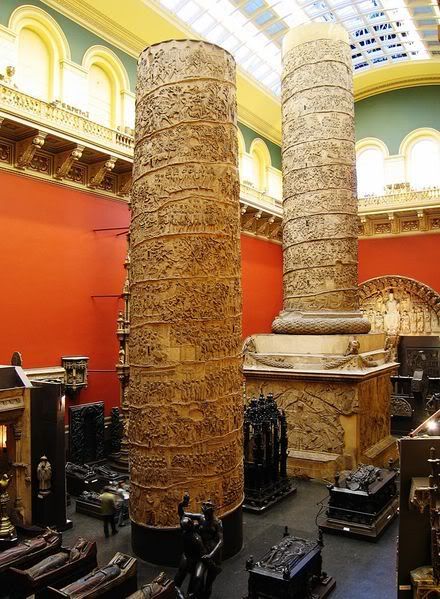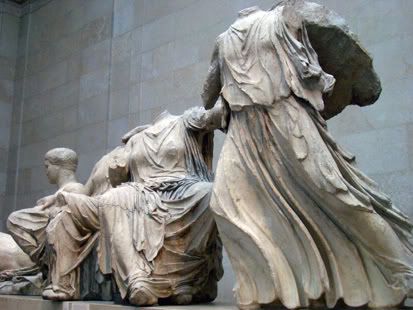Trajan's column, sculpture cast court, V&A
Some of my experiences in London this past week are recirculating through my head, like a song that keeps returning. I set down here a few notes for those who are planning a visit or who are interested in London.
The Victoria and Albert
After spending the morning at the Byzantium exhibit (described in the previous entry) I hopped on the Tube and alighted at South Kensington. After lunch at an Indian restaurant I remembered from a previous trip -- Indian food in central London is generally of a high standard -- I went to the Victoria and Albert Museum, known as the "V&A," or as the world's attic. The latter description is not too far-fetched. It is filled with no end of arts and crafts, like a gigantic house owned by the most obsessive, long-lived collector imaginable.
If there is some sort of handiwork you fancy -- silver, glassware, costumes, German medieval and Renaissance wood carving, name it -- you're in for a peak experience at the V&A, but don't forget to bring emergency oxygen. By the time you have looked on the products in your field of interest, from century after century, in display case after case, room after room, you may find your head spinning, your knees week, your feet groaning, and be ready to plead for a stop to it.
I first headed, as planned, to the sculpture cast courts. They contain a collection of casts made in the 19th century of famous and not-so-famous sculptures from throughout history. Other than not being made of the original materials, they are actual-size accurate models that you can study at your leisure, many of them more closely than you could the real items. Trajan's column from Rome, an amazing pictorial record of the Emperor's military campaigns carved in low relief, can hardly be seen in situ because it is, understandably, fenced off to protect it; but the model in the V&A is bang in front of you. Not only that, but the installers sawed it in half so the middle part is nearer to eye level.
Minbar, a sort of Muslim pulpit,
from a Cairo mosque. Jameel Gallery
The newest room at the museum is the Jameel Gallery of Islamic Art, added with much acclaim in 2001. It would be a cheap shot to suggest that the Jameel Gallery is a symptom of the Islamization of Britain. The world of Islam has produced marvelous art and craftsmanship, and the V&A's new gallery offers examples that are well worth getting to know.from a Cairo mosque. Jameel Gallery
The intricate geometric designs, the richly patterned carpets, the elaborately decorated Korans -- fabulous stuff. And has there ever been a more beautiful form of writing than the old Arabic script in the illuminated manuscripts on view here?
The British Museum
You want to see the Parthenon sculptures, of course. I have a couple of times before, but this was the first time I felt that I really appreciated them.
Heavily damaged, missing some of their surviving pieces (which are in Greece), and out of context, the sculptures are not necessarily easy to warm to. They consist of three different elements: metopes, from the roof, which are low relief carvings of scenes of fighting between centaurs and Lapiths (a mythical race); the frieze, a continuous scene of a procession, which ran all around the outside of the temple; and the pediment sculptures.
The metopes are technically skilled but limited in variety; not especially compelling. The frieze is much more interesting, but hard to comprehend. Because of the need to display them facing into a room, when they were originally facing out from the building, their aspect is reversed. Besides that, instead of running continuously around, they are placed on two walls opposite one another. But even damaged, and with pieces missing, the frieze contains graceful carving and communicative details.
The remains of the sculptures from the east pediment and the west pediment face each other on opposite sides of the hall. Again, they would have originally faced in opposite directions, but here that's not much of a problem. The east pediment sculptures are the greatest glory of the whole group, and even in their broken state convey a moving sense of the highest ideals of the people of the Athenian city-state.
The other rooms devoted to classical artifacts are first-class too. I was delighted to be able, once again, to look on the justly celebrated Portland Vase from ancient Rome -- the most beautiful of its kind I've ever seen.
The museum is generally horribly crowded. Get there when it opens to have a few precious moments to look at its wonders in relative tranquility.
Twelfth Night, with Derek Jacobi and Victoria Hamilton
I had read "Shakespeare's" Twelfth Night, but never seen it performed, even on television. (The quotes around "Shakespeare" are because I am one of those nutters who are convinced that the actor-manager from Stratford had at most a small hand in writing the plays published under his name.) It does not strike me as one of the author's better efforts, but seeing it played in a West End theater almost made me change my mind. Almost.
The U.K. is going downhill fast in many ways, but in acting it's enjoying a Golden Age, has been for some years. Why this should be so in a culture that is otherwise moribund is an interesting question, one to which I have no answer except perhaps that the English have always been avid theatergoers and there is a solid tradition that is maintained in schools like the Royal Academy of Dramatic Arts. Anyway, you could probably cast 500 plays simultaneously with excellent actors from the country's major cities.
Needless to say, Derek Jacobi was a treat as Malvolio. I'd never seen him on stage before, and never in a semi-comic role, which he pulled off with great élan. Jacobi and Anthony Hopkins are probably the greatest all-around actors since Olivier, and it's only because neither has ever had as much glamorous appeal as Olivier that they don't have the same worshipful following.
I was just as keen to see Victoria Hamilton playing Viola. She is not well known in the United States, although much respected in British theatrical circles -- well, she would be, to be cast alongside Jacobi, wouldn't she? Hamilton provided the only light and humanity as Cordelia in Richard Eyre's otherwise nearly unwatchable King Lear for TV, and was also outstanding playing her namesake in the historical soap opera Victoria and Albert. I was not disappointed. She offered comic aplomb and touching lovesickness in this Twelfth Night. The rest of the cast was mostly excellent, although I thought Indira Varma (who played Titus Pullo's ill-fated wife in the HBO Rome) was a bit too coy and superficial as Olivia.

Titian, Bacchus and Ariadne
The National Gallery
Before and after Twelfth Night, I was able to spend a little time in the National Gallery (fortunately only a five-minute walk from the theater). This gallery of paintings is in every respect worthy of the great nation that Britain once was, and one would like to think, might someday be again.
I began in the Dutch section where I was reacquainted with "old friends" by Rembrandt, Vermeer, Metsu, Teniers, De Hoogh, and Jacob van Ruisdael. The latter is my favorite landscape painter of all time, and I usually have his paintings to myself, because he is anything but a crowd pleaser. But those swelling, metallic clouds -- the somber shadowed countryside with a spotlit patch of sunlight -- the liquid silver streams ... these chilly views of Holland are sad, contemplative, Zen-like in their perfect stillness, catching eternity in every branch and leaf.
After the play, I returned to the gallery to those geniuses of the Italian late Renaissance, Titian, Veronese, Tintoretto, all astonishing colorists in their individual ways. No matter how many times I see it (I guess this was the fourth time), Titian's Bacchus and Ariadne blows my mind. But I made it a point to absorb some of the master's other, less spectacular pictures, which were also compelling my admiration ...
When it was announced that the gallery would shortly be closing, at 6 p.m. A disappointment because the museum normally stays open until 9 on Wednesdays, but it being New Year's Eve ...
I used the last few minutes to try to impress on my mind one Tintoretto that I really wanted to "keep" -- but I find now that I cannot recall it, even its name. More time, more time, please.
But that's London. There is always so much more, just around the corner. You can't quite grasp its essence, it is too big, too varied, elusive. You leave impressed beyond words, but London is not yours, will never be yours, will only allow you glimpses of its own past magnificence that lingers in places, and the treasures it holds from every civilization since humans began making things that would last longer than their individual lives.
It is older than you in your present incarnation and will not yield all its secrets. So this city that began as Londinium, for the Romans who braved the back of the northern wind, bids you to return to know still more of it, but not enough, not ever enough.






3 comments:
One of the reasons Britain may be enjoying a Golden Age in acting is because theatre and performance generally flourish in decadent societies, as the Romans knew, and as Rousseau reminded modern men. This is why Rousseau welcomed the theatre in Paris but argued against it in virtuous Geneva in his famous "Letter to d'Alembert on the Theatre." It's one of Rousseau's best pieces of applied political philosophy as it is grounded in historical example. Similarly, after WWII, when Europe was on its knees, it produced some of the best films ever. Here, also, I believe the 1970's saw the best American cinema and was one of the darkest eras - or so I am told of the times I was born. Acting is an essentially immoral activity from the perspective of Roman civics. Makes sense really.
Did your experience of London match the Daily Mail's reporting?
S,
An interesting theory, but hard to justify, I think. Were Aeschylus, Sophocles, and Euripides living in a decadent society? Congreve, Goldsmith, and Sheridan? "Shakespeare"?
Anonymous,
Well, no. I didn't get knifed or beaten up. But my visit was limited to tony areas, Kensington, Bloomsbury, and Piccadilly, that generally don't see much mayhem.
I had planned to write another posting, about social conditions I observed in London, but wondered if the subject of the city was beginning to wear out its interest for readers. Maybe I will post some comments along those lines.
Post a Comment